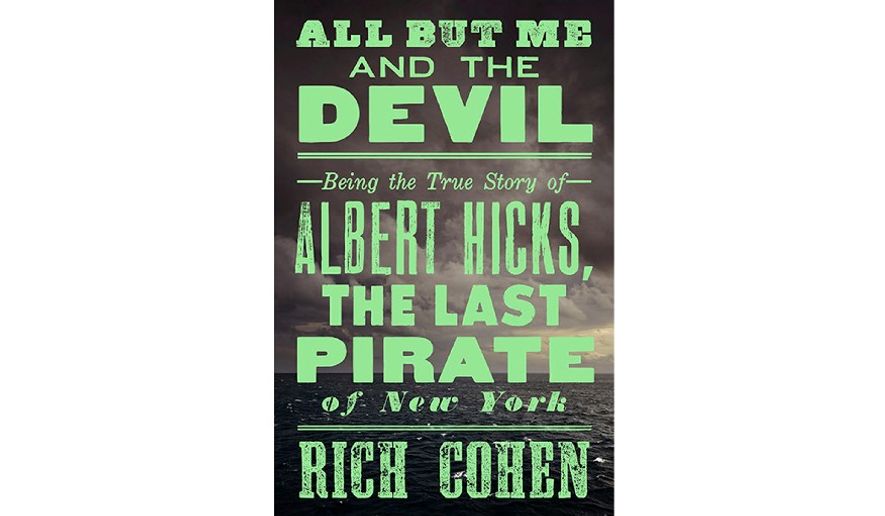OPINION:
I loved Rod Serling’s “The Twilight Zone” when I was a teenager in the 1960s.
One episode I recall was “The New Exhibit,” in which Martin Balsam portrayed the curator of “Murderer’s Row” in a wax museum who later goes mad. The TV program opened with the curator speaking to a group of visitors about the wax figures of infamous killers, such as Jack the Ripper. The first murderer the curator introduced was an infamous sailor who murdered his fellow crew members in 1860. The ferocious, life-like, ax-wielding wax figure glared angrily at the museum visitors.
And that was my introduction to Albert Hicks, the subject of Rich Cohen’s book, “The Last Pirate of New York: A Ghost Ship, a Killer, and the Birth of a Gangster Nation.”
Mr. Cohen notes that while other children heard fairy tales, his father told him tales about the criminal legends of his New York childhood, such as Louis “Lepke” Buchalter and “Charlie Lucky” Luciano. As a writer, he later discovered that criminals had also grown up on gangster stories told by their fathers.
“It gave me a mission, inspired a quest: I would track down and name and chronicle the very first New York gangster, the man behind all the other legends,” Mr. Cohen writes.
Monk Eastman is considered to have been the first, and then there was Bill “The Butcher” Poole (both of whom were featured in Martin Scorsese’s “Gangs of New York”). Mr. Cohen wondered who they were told stories about?
“Albert Hicks is the closest thing the New York underworld has to a Cain, the first killer and the first banished man, carrying that dread mark: MURDER,” Mr. Cohen explains. “He operated in a city so similar to and yet so different from our own, the word gangster had not yet been coined. He was called a pirate.”
The crew of a schooner hauling molasses to Philadelphia discovered the ghost ship by colliding with it off New York. The captain called out to the ship but when no one returned the hail, they went aboard the mysterious ship and discovered that no one was aboard and found the deck and captain’s quarters awash in blood.
The ghost ship, called the E.A. Johnson, was towed into New York and the police went aboard to investigate. The police discovered three holes had been bored in a failed attempt to sink the ship, and they discovered four severed fingers and a thumb.
Old New York was a major seaport and merchants, bartenders, stage performers, bankers, cops and criminals lived of the sailors. Mr. Cohen notes that all kinds of criminals operated along the East River, such as pickpockets, con artists, pimps, prostitutes, opium dealers, addicts and loan sharks.
And pirates.
“An 1850 police report estimated the presence of between four hundred and five hundred pirates in New York City,” Mr. Cohen writes. “To the police, a pirate was any criminal who made his living on the water, attacking and robbing ships beyond the jurisdiction of the landlocked coppers — named for the tin badges on their peaked caps.”
Albert Hicks was one New York’s pirates. Under an assumed name he signed onto the E.A. Johnson and he later murdered the captain and the two mates with an ax. Stealing money and valuables from the ship, he escaped on the ship’s yawl and headed ashore.
Mr. Cohen quotes the many newspaper accounts of the E.A. Johnson murders and introduces the readers to a New York Times reporter named Elias Smith. According to Mr. Cohen, Elias Smith had a gift for dialogue and a taste for action. He covered everything, but he especially liked covering crime.
Elias Smith accompanied the two New York detectives on the trail of Albert Hicks, as he told the detectives that he had grown up in Providence, Rhode Island, and knew the streets and wharves.
Hicks was located and as he had the money and the murdered sailors’ personal items in his possession, he was arrested and taken back to New York for trial.
Mr. Cohen tells us that Hicks was cold-hearted and calculating. He was a big, strong and handsome man, and he became something of a celebrity. Sentenced to hang, he sold his life story to a newspaper prior to his death and most of the book covers his account of his life of murder and theft on ships and in ports around the world.
Mr. Cohen made good use of the information he mined from police records, court documents and newspaper accounts. “The Last Pirate” is an interesting and well-researched look back at the life and times of a notorious pirate, gangster and killer.
• Paul Davis covers crime, espionage and espionage.
• • •
THE LAST PIRATE OF NEW YORK: A GHOST SHIP, A KILLER, AND THE BIRTH OF A GANGSTER NATION
By Rich Cohen
Spiegal & Grau, $28, 256 pages




Please read our comment policy before commenting.